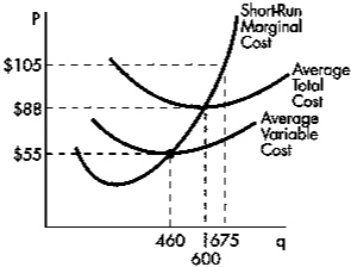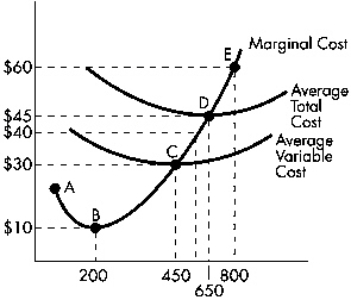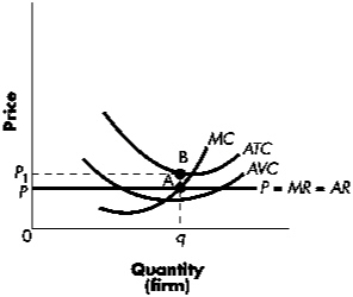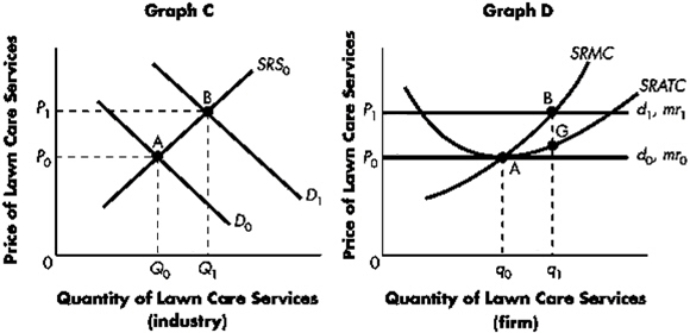A) average fixed cost curve.
B) average variable cost curve
C) average total cost curve
D) marginal revenue curve.
Correct Answer

verified
Correct Answer
verified
Multiple Choice
Which of the following is not true in the long run under perfect competition?
A) There is no incentive for firms to enter or exit the industry.
B) Economic profit is zero.
C) Long-run marginal cost is minimized.
D) Long-run average total cost is minimized.
Correct Answer

verified
Correct Answer
verified
Multiple Choice
Which of the following is true about the long run operations of perfectly competitive firms?
A) They produce with productive efficiency.
B) They produce with allocative efficiency.
C) They earn zero economic profits.
D) all of the above
Correct Answer

verified
Correct Answer
verified
Multiple Choice
If a perfectly competitive firm is operating in the short run and seeks to maximize profit,the firm should:
A) increase output whenever marginal cost is less than average total cost.
B) increase output whenever marginal revenue is less than marginal cost.
C) choose the output where per-unit profit is greatest.
D) increase output whenever price exceeds marginal cost.
Correct Answer

verified
Correct Answer
verified
Multiple Choice
Exhibit 12-2  Refer to Exhibit 12-2.When the market price equals $105,and the firm sells 675 units of output,the firm:
Refer to Exhibit 12-2.When the market price equals $105,and the firm sells 675 units of output,the firm:
A) is earning a normal profit.
B) is earning positive economic profits.
C) is experiencing a loss, but should continue operating temporarily because business conditions may improve.
D) is experiencing a loss and should shut down.
Correct Answer

verified
Correct Answer
verified
Multiple Choice
Which of the following is true about increasing cost industries?
A) They use a large portion of available specialized input resources in production.
B) In order for industry output to expand, the prices of the specialized inputs will increase.
C) Expansion of industry output leads to a higher equilibrium price in the long run.
D) All of the above are generally true of increasing cost industries.
Correct Answer

verified
Correct Answer
verified
Multiple Choice
Toys for Toddlers,Inc.,sells in a perfectly competitive market,with an equilibrium price of $5.Its marginal revenue:
A) is greater than $5.
B) is $5.
C) is less than $5.
D) is less than zero.
Correct Answer

verified
Correct Answer
verified
Multiple Choice
Exhibit 12-5  Refer to Exhibit 12-5.A profit-maximizing firm in a perfectly competitive industry will produce ____ units of output if the market price equals $45.
Refer to Exhibit 12-5.A profit-maximizing firm in a perfectly competitive industry will produce ____ units of output if the market price equals $45.
A) 800
B) 650
C) 450
D) 200
Correct Answer

verified
Correct Answer
verified
Multiple Choice
Exhibit 12-6  Refer to Exhibit 12-6.If P represents the market price for a price-taking firm,the best course of action in the short run for the firm is to:
Refer to Exhibit 12-6.If P represents the market price for a price-taking firm,the best course of action in the short run for the firm is to:
A) shut down immediately.
B) continue operating because average total cost exceeds price.
C) continue operating because price exceeds average total cost.
D) continue operating because price exceeds average variable cost.
Correct Answer

verified
Correct Answer
verified
Multiple Choice
Exhibit 12-9  Refer to Exhibit 12-9.Using Graph C,which of the following statements is not true?
Refer to Exhibit 12-9.Using Graph C,which of the following statements is not true?
A) There has been an increase in demand in the market.
B) There has been an increase in supply in the market.
C) The equilibrium price in the market has increased from P0 to P1.
D) There has been a change in quantity supplied from Q0 to Q1.
Correct Answer

verified
Correct Answer
verified
Multiple Choice
If a perfectly competitive firm's marginal revenue was less than its marginal cost,
A) it would raise its price in order to increase its profits.
B) it would contract its output but not raise its price in order to increase its profits.
C) it is currently earning economic losses.
D) both (a) and (c) are true.
Correct Answer

verified
Correct Answer
verified
Multiple Choice
Marginal revenue is:
A) the additional cost incurred from producing one more unit of output.
B) the addition to total profit from selling one more unit of output.
C) the addition to total revenue from selling one more unit of output.
D) the addition to total output from hiring one more unit of labor.
Correct Answer

verified
Correct Answer
verified
Multiple Choice
A perfectly competitive firm has no influence over price because:
A) its output is insignificant relative to the market as a whole.
B) antitrust laws constrain perfectly competitive firms.
C) consumers establish the prices of products.
D) it is unaware of the demand curve it faces.
Correct Answer

verified
Correct Answer
verified
Multiple Choice
Which of the following is true of perfectly competitive firms?
A) It is difficult for entrepreneurs to become suppliers of a product in a perfectly competitive market structure.
B) A perfectly competitive firm has a perfectly elastic supply curve.
C) In a perfectly competitive market, an individual seller can change his price and it will not alter the output he sells.
D) None of the above are true.
Correct Answer

verified
Correct Answer
verified
Multiple Choice
If the perfectly competitive wiffle ball industry is bearing economic losses,we would expect that:
A) output will increase, the price of wiffle balls will rise, and the economic losses would tend to disappear.
B) output will decrease, the price of wiffle balls will fall, and the economic losses would tend to increase.
C) output will decrease, the price of wiffle balls will rise, and the economic losses would tend to disappear.
D) output will increase, the price of wiffle balls will fall, and the economic losses would tend to disappear.
Correct Answer

verified
Correct Answer
verified
True/False
It is relatively easy for firms to enter and exit a perfectly competitive market.
Correct Answer

verified
Correct Answer
verified
True/False
A firm that is earning zero economic profits has a strong incentive to exit the industry.
Correct Answer

verified
Correct Answer
verified
Multiple Choice
Which of the following best resembles a perfectly competitive market?
A) a stock market
B) the book publishing industry
C) the steel industry
D) the used car industry
Correct Answer

verified
Correct Answer
verified
Multiple Choice
In a perfectly competitive market,in response to a permanent decrease in demand:
A) the short run equilibrium price will be higher than the eventual long run equilibrium price.
B) the short run equilibrium price will be lower than the eventual long run equilibrium price.
C) the short run equilibrium price will be the same as than the eventual long run equilibrium price.
D) we cannot know whether the short run equilibrium price will be above, below or equal to the eventual long run equilibrium price.
Correct Answer

verified
Correct Answer
verified
Multiple Choice
A firm facing a horizontal demand curve:
A) cannot affect the price it receives for its output.
B) is unlikely to price its goods below market price.
C) faces a perfectly elastic demand curve for its product.
D) is characterized by all of the above.
Correct Answer

verified
Correct Answer
verified
Showing 121 - 140 of 207
Related Exams